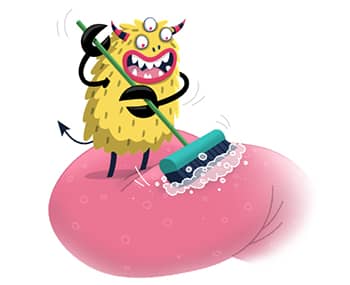Pediatric Bad Breath Halitosis in Children
How to Prevent Bad Breath in Children
Bad breath, or halitosis, has been around for centuries and is even mentioned in the Talmud as a grounds for divorce.
While malodors emanating from the mouth are more frequent in adults, they may occur in children. In either case, the odor-causing culprits are Gram negative anaerobic oral bacteria that decompose proteins to amino acids. Further bacterial decomposition of the sulfur-containing amino acids, cysteine and methionine, generate foul-smelling sulfides, such as hydrogen sulfide, dimethyl sulfide, and methyl mercaptan (the “rotten egg odor”).
Sources of Halitosis
 The most common odor-producing sites in the oral cavity include:
The most common odor-producing sites in the oral cavity include:
- the back of the tongue
- the spaces between neighboring teeth
- the spaces under the gingiva (gum line)
Food particles and cellular debris accumulate in those areas.
The back of the tongue, with its convoluted surface containing grooves and crevices, is an ideal trap for the accumulation of food debris, dead desquamated epithelial cells from the surface of the tongue, postnasal drip, and anaerobic bacteria. This region of the tongue is seldom properly cleansed, allowing the bacteria an opportunity to proliferate and metabolize the protein-containing materials to yield volatile sulfur-containing gases.
The suggested treatment for halitosis as related to tongue-related halitosis is gentle cleaning of the surface of the back surface of the tongue with a soft-bristled brush, or with a tool designed to clean the tongue: a tongue scraper.
Postnasal Drip is Another Potential Cause of Halitosis
Every day glands in the nose produce about one quart of mucus, a thick protein-containing substance whose function is to moisten the nasal passages and to trap impurities.
Under normal conditions, mucus mixes with saliva and moves harmlessly down the throat. Allergies, viruses (such as influenza virus and common cold virus), and microbial sinus infections trigger the production of excess mucus, which drips down the throat.
Termed postnasal drip, mucus that falls on the back of the tongue is an excellent substrate for bacterial decomposition activities and is thought to play a major role in halitosis in those children with numerous cold and sinus infections.
Bacterial Decomposition Activities of Food Debris Between Adjacent Teeth Are Another Source of Halitosis
Toothbrush bristles alone cannot clean effectively in these tight spaces.
The American Dental Association (ADA) states that flossing in combination with tooth brushing can help prevent halitosis and gum disease (gingivitis). Flossing removes both the trapped food debris between adjacent teeth and the biofilm of bacteria that forms between adjacent teeth. Although these are proven facts, recent studies diminish the importance of self-flossing, as opposed to professional flossing by a dentist.
Gingivitis, common in children, may manifest as recurrent bad breath, accompanied by reddened, puffy gums that easily bleed and that may eventually retract from the teeth.
Gingivitis can be controlled by better oral hygiene, with the child brushing twice a day. Should the condition worsen, professional dental cleaning may be required to eliminate:
- plaque
- build-up of tartar
- hardened plaque
That form below and above the gum line and require removal by a dentist.
Another cause of childhood bad breath is related to a child’s breathing pattern (“mouth breathing” versus “nose breathing”), which affects the flow of saliva, which in turn affects the amount of oral bacteria in the mouth.
Breathing through the mouth, either due to habit or because of a stuffy nose, can dry out saliva from the oral cavity. Without saliva, the anaerobic bacteria proliferate causing bad breath. Conversely, breathing through the nose creates a moist environment, allowing saliva to saturate the oral cavity. Saliva, with its antibacterial properties, destroys bacteria and serves as a natural wash for the mouth. For children with halitosis due to a dry mouth, the treatments are relatively simple.
The child should drink plenty of water and chew sugar-free gum to stimulate the secretion of saliva from the salivary glands. Starting a child’s day with a nourishing breakfast is a healthy way to stimulate saliva flow and to lower the number of bacteria within the oral cavity.
Lastly, tonsils, which are natural growths of lymphoid tissue, can also be the site of halitosis. When enlarged during infection, the tonsils trap food and bacteria. In extreme instances, stones called “tonsilloliths” (hardened, calcified accumulations of debris) may emit a strong odor. If diagnosed, an ear nose and throat (ENT) physician should be consulted.
In summary, the key to prevent halitosis is children is maintaining proper oral hygiene, including:
- tongue cleaning
- tooth brushing
- flossing
- developing into the habit of nose (rather than of mouth) breathing
- drinking ample amounts of water
- maintaining an adequate flow of saliva
For more information about pediatric bad breath halitosis in children or to learn more about our New York pediatric dentistry practice located in New York City on the Upper East Side please call hospital and university trained pediatric dentist Dr. Sara Babich at: 212.988.4070
Pediatric Dentistry: Dr. Sara B. Babich, DDS
116 E 84th St
New York, NY 10028
(84th St. btw Park Ave / Lex Ave)
☎ 212-988-4070
 Contact us today to learn more about our
Contact us today to learn more about our New York City pediatric dentistry practice
 212.988.4070
212.988.4070